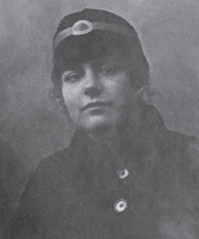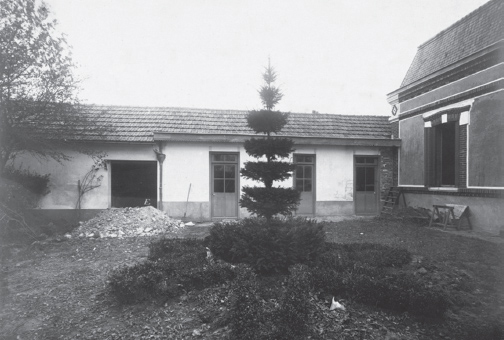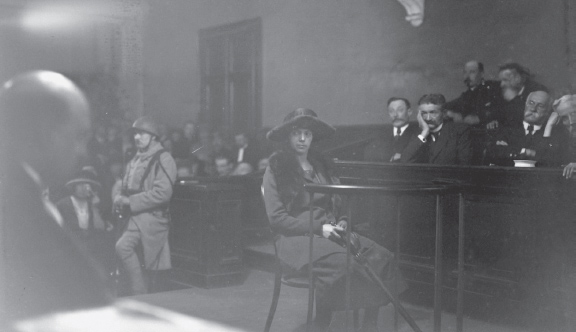

A night at the Opéra-Comique, 1918: Landru and his mistress Fernande Segret pose for a souvenir snap before heading to their favourite Paris theatre. (Roger-Viollet Collection, Paris)
THE DISAPPEARANCES (1915–1919)

Jeanne Cuchet, pretty, deaf, and secretive. She declined to reveal why she returned to her fiancé after discovering he was an imposter. (Archives de la Préfecture de police de Paris)

Jeanne’s beloved only son André, who disappeared with her in early 1915. “I could not keep the boy under surveillance,” Landru recalled. (Archives de la Préfecture de police de Paris)

‘Brazil’, Landru’s codename for the Argentinian Thérèse Laborde-Line. She was last seen picking cherries in his back garden at Vernouillet in the summer of 1915. (Archives de la Préfecture de police de Paris)

Marie-Angélique Guillin, Landru’s third known fiancée, thought she was marrying France’s Consul-General to Australia. She never got further than Vernouillet. (Archives de la Préfecture de police de Paris)

Anna Collomb, thrifty and intelligent, but a poor judge of men. She trusted Landru enough to let him buy her a one-way ticket to his country home at Gambais. (Archives de la Préfecture de police de Paris)

Flirty Andrée Babelay, just 19 when Landru spotted her one evening on the Paris metro. “He is my father but I call him ‘Lulu’,” Andrée told villagers in Gambais. (Archives de la Préfecture de police de Paris)

Célestine Buisson, homely and naïve, who disappeared at Gambais in August 1917. “If I take a husband it is to cherish him,” she told her monsieur. (Archives de la Préfecture de police de Paris)

Louise Jaume, estranged from her husband, sought God’s forgiveness for answering a lonely hearts advert. She made Landru pray with her in the village church at Gambais. (Archives de la Préfecture de police de Paris)

Marie-Thérèse Marchadier, a prostitute who supposedly had a “mania for marriage” and Landru’s last known fiancée. She vanished in January 1919. (Archives de la Préfecture de police de Paris)

Annette Pascal found her fiancé almost as terrifying as the German bombardment of Paris. “Be very worried,” Annette wrote to her sister on the day she disappeared at Gambais. (Archives départementales des Yvelines)
THE INVESTIGATION AND TRIAL (1919–21)

17 April 1919: Five days after his arrest, Landru poses for a photo in the town jail at Mantes. He found his cell agreeable and resented his transfer to the Santé prison in Paris. (Archives départementales des Yvelines)

The Lodge at Vernouillet, 35 kilometres north-west of Paris, which Landru rented in Jeanne Cuchet’s name in December 1914. The pavilion (left) connected with the main villa (centre), while the neighbours lived in the white house (right). (Archives départementales des Yvelines)

From the rear, The Lodge’s peculiar construction was more apparent. The villa (left) and the pavilion (centre) were overlooked by Landru’s incurious neighbour Mme Picque. (Archives départementales des Yvelines)

15 April 1919: The investigating magistrate Gabriel Bonin (fifth from left) inspects forensic samples taken from the rear garden of The Lodge. Bonin mistakenly thought it would only take a few days to solve the case. (Roger-Viollet Collection)

11 May 1919: L’Étang des Bruyères, near Gambais. The detectives Dautel (left, half-obscured) and Belin listen to Mme Mauguin describe what she saw floating on the water. Her evidence did not fit the prosecution case. (Roger-Viollet Collection)

The Villa Tric, 55 kilometres south-west of Paris, which Landru rented as ‘Raoul Dupont’ from 1915 to 1919. The village of Gambais (left) is just visible in the distance. (Archives départementales des Yvelines)

The rear of the Villa Tric and its outhouses from a distance, showing the property’s isolation. The village church (left) is 250 metres away, while Gambais (right, out of picture) is more than a kilometre in the opposite direction. (Archives départementales des Yvelines)

The Villa Tric’s kitchen, with Landru’s notorious little oven in the far corner. “It is a ridiculous utensil, scarcely bigger than a bedside table,” one journalist commented. (Archives départementales des Yvelines)

The Villa Tric’s rear enclosure, showing the unearthed grave (left) of Marie-Thérèse Marchadier’s three strangled dogs, close to where Landru buried Annette Pascal’s cat. (Archives départementales des Yvelines)

The open hangar (left) where Landru stored dead leaves, next to two locked sheds where Célestine Buisson’s sister peered through the keyhole at a bundle of indistinct shapes. (Archives départementales des Yvelines)

27 May 1919: Paris, Palais de Justice. Landru, handcuffed to his prison escort, is led away after his first formal interrogation. “It’s for you to prove the deeds of which I’m accused,” he sneered at Bonin. (Roger-Viollet Collection)

Paris, 18 December 1919: Landru’s wife Marie-Catherine, proven forger and liar, looks stern in a police mugshot on the day of her arrest. “My only crime is to have loved him too much,” she insisted. (Archives de la Préfecture de police de Paris)

Landru’s son Maurice, a convicted swindler, also denied complicity in his father’s crimes. Prison was “no hassle”, Maurice told a reporter nonchalantly. (Archives de la Préfecture de police de Paris)

“Your proofs, messieurs, where are your proofs?” Caustic and volatile, Landru was the despair of his defence counsel during the trial. (Archives de la Préfecture de police de Paris)

Mistinguett (‘×’), the queen of French musical theatre, was obsessed by Landru and pretended to be reporting on the trial for an English newspaper. Other celebrities who came to watch included Maurice Chevalier and the film star Sacha Guitry. (Archives de la Préfecture de police de Paris)

Jeanne Cuchet’s friend Louise Bazire glares back at Landru while the jury listens to the judge. Inconveniently for the prosecution, Mme Bazire insisted Jeanne was poor. (Gallica, Bibliothèque Nationale)

Célestine Buisson’s sister Marie Lacoste, the best detective in the case, glares at Landru. Without her, Landru might never have been arrested. (Alamy)

…and then came Annette Pascal’s niece Marie-Jeanne, dressed to kill and intent on humiliating Landru. “The monsieur was so gentle in bed with my aunt,” she taunted him. (Alamy)

Juliette Auger, plain and shy, who shredded Landru on the witness stand. (Gallica, Bibliothèque Nationale)

Maurice Gilbert (left), the presiding judge, clever and vain, and Robert Godefroy (right), the slow-witted prosecuting attorney. (Archives de la Préfecture de police de Paris and Gallica, Bibliothèque Nationale)

Vincent de Moro Giafferri, Landru’s brilliant defence attorney, waits impatiently to launch his electrifying closing address. (Gallica, Bibliothèque Nationale)

30 November 1921, evening: The jurors smile at the camera as they wait to stuff their verdicts in the urn. “They are mostly petits bourgeois, with just one timid, moustachioed worker among them.” (Archives de la Préfecture de police de Paris)

30 November 1921, evening: Landru waits in a holding cell beneath the court while the jury decides his fate. “On the heads of my family I swear that I have killed no one.” (Archives de la Préfecture de police de Paris)